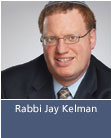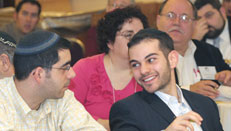 |
||||||||||||
| Weekly Parsha | ||
| Current Week | ||
| Parsha Archives | ||
| Business Ethics | ||
| Dr. Malamet Speaks Out | ||
| TiM MP3 Library | ||




A Thought for the Week with Rabbi Jay Kelman
|

The prayer for the welfare of the State of Israel, recited in many of our congregations assumes that the modern day state is the "beginning of the flowering of our redemption". For many the notion that a secular state could herald the redemption was and remains unthinkable while others maintain that it is best to proclaim our ignorance of G-d's historical plans. Interestingly an alternate version of the prayer for the State of Israel used in many synagogues in Britain omits this phrase. While we may debate the definition of the beginning of the redemption, defining the end of the redemption seems clear. The Ramban in his introduction to the book of Shemot notes that sefer shmot is the book of redemption, sefer hageulah . Redemption, the Ramban asserts has three components. The first prerequisite for redemption is physical freedom, a subjugated nation can never be a great nation. Physical freedom must lead to the second dimension of redemption, the spiritual redemption begun at Sinai. This stage is closely followed by the third and final stage, the building a Tabernacle within which the Divine presence would continue to dwell. The building of the mishkan thus marks the culmination of the redemptive process and cogently explains why its myriad details are the focus of the concluding half of sefer shemot . By analyzing the main functions of the mishkan, and its successor, the Beit HaMikdash we should gain a clearer understanding of the ingredients necessary to attain geulah , redemption. Contrary to the misconception of many the Temple 's primary function is not the offering of sacrifices. The Beit Hamikdash is first and foremost a place of prayer, not only for Jews but for all peoples. "For my home is a house of prayer for all nations"(Isaiah 56:7) is a refrain we say over and over again before and during Yom Kippur. Interestingly Jewish law demands that we juxtapose the blessing of redemption ga'al yisroe to prayer ( somech geulah letefillah ). In addition to its role in developing our relationship with G-d, the mikdash was the gathering place for the Jewish people. All were required to join together as we celebrated our past and gained guidance for our future. All were required to contribute equally to the upkeep of the temple by donating a half shekel, half representing the incompleteness of man, the need for others in order to create holiness. The mikdash served, not surprisingly as the central lost and found depot, one more way to connect the Jewish people with each other. Coming together as a people, coming together in prayer would undoubtedly inspire within us awe towards the Creator. In describing the maasser sheni , the second tithe which required the farmer to either consume (close to) 10% of his produce in Jerusalem or spend the equivalent (plus a 25% premium) in the holy city the Torah tells us that "you must eat this before G-d your Lord in the place that He will choose so that you will learn to fear the Lord your G-d all the days" (Devarim 14:23). The occasional visit to the mikdash was to provide the necessary inspiration so that we maintain the awe of G-d throughout the year. The Temple served as the official place of the Sanhedrin, the high court, who in the words of the Rambam were "the main (teachers) of the oral law and they were the pillars of guidance" teaching and guiding the Jewish people. Reaching out to G-d in prayer, coming together with our people, growing in Torah, feeling the presence of the Divine; this is what we yearn for when we pray for the rebuilding of the Temple . The bringing of korbanot was the tangible symbol of our growth in these areas - sacrifices brought without any positive changes were, as our prophets constantly noted, less than worthless. "And you shall make for Me a temple and I will dwell among them". The temple is the home of G-d. May we soon merit receiving an invitation to come and visit heralding the completion of the book of redemption. Shabbat Shalom
|
|
|

 |
 |